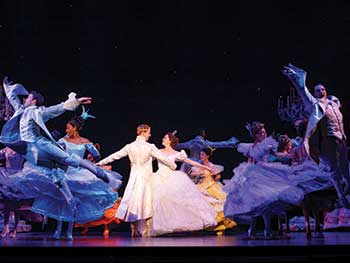
Rodgers + Hammersteins’s Cinderella, which plays the Ahmanson Theatre March 17-April 26, is based on a 1957 television special that starred Julie Andrews; two more TV versions of the Broadway musical, starring Lesley Ann Warren and Brandy, first aired in 1965 and 1997, respectively.
Cinderella, of course, is a happily-ever-after fairy tale about a young woman finding her prince. So in arranging its lilting ballad of love at first sight, “Ten Minutes Ago,” why was musical supervisor David Chase inspired by the music of doomed love and New York street gangs in West Side Story?
“In 1957, the height of romance was a nice waltz, elegant and sophisticated,” says Chase. “But the audiences’ ears have changed. Now, that would sound like—” he plays a waltz rhythm on the piano with an oom-pah-pah flavor.
“How do you not make that sound old-fashioned?” Chase continues. “But I also don’t want to do something modern; I want to do it in the time period.”
His solution? West Side Story opened on Broadway in 1957, and, says Chase, composer Leonard Bernstein used musical structures similar to those of Richard Rodgers, such as the sharp-fourth interval of notes (think WSS’ “Cool”). So he used that more modern-sounding interval in the arrangement of “Ten Minutes Ago” to honor the period but also “give it a little more richness in the harmonic motion.”
The melody line is only one element in the various performing genres. “The harmonies, transitions, accompaniment, who sings—all those are components of the arrangements,” says Chase, also musical supervisor for Nice Work If You Can Get It, playing the McCallum Theatre in Palm Desert (March 13-15) and Segerstrom Center for the Performing Arts in Costa Mesa (March 17-22); he has credits as musical director, supervisor, arranger and/or dance arranger on numerous other Broadway shows.
The arranger shapes the music into a theatrical piece. “I’m thinking of the whole picture, the arc of the song,” Chase says. “Is there dialogue? How complex is the accompaniment? Is there a break in the harmony?”
He might add a musical bridge between songs or instrumental sections; let the audience know a song is ending with a crescendo and an accent; or add variety to a repetitive melody, such as “The Prince Is Giving a Ball,” with new lyric and rhythmic phrases. The orchestrator then assigns instruments that create desired textures and timbres.
In dance, the lushness of the string section would be the expected complement to classical ballet, but for a contemporary company such as Alvin Ailey American Dance Theater, playing the Dorothy Chandler Pavilion April 15-19, anything goes.
“Each choreographer has a different objective,” says choreographer and Ailey rehearsal director Matthew Rushing, whose Odetta spotlights the late singer-songwriter and civil-rights activist and has its West Coast premiere during the engagement.
“Some will use dance in concert with the music; for some, the movement will be in contrast. Say you have a huge choral piece—it’s assumed you’d need a lot of dancers, because there are many voices, to match the size of the sound. But you don’t. When you’re dealing with creativity, the minute you come up with a formula, the choreographer will break that formula.”
For Odetta, a 40-minute piece that includes Odetta’s songs and spoken words, Rushing felt that the finale music was too heavy. “I brought up the tempo and did a ritard at the end, to give it an uplifting end,” he says. He also worked with Odetta’s pianist, Seth Farber, replacing Odetta’s guitar for the arrangement.
Even jazz, noted for its improvisation, utilizes arrangements. Whereas some composers, such as the late Charlie Parker, take existing tunes and change the melody, “we do the opposite,” says Edward Simon, pianist for the SFJAZZ Collective, an eight-member ensemble that plays the Wallis Annenberg Center for the Performing Arts in Beverly Hills on April 19. “We leave the melody intact and change the harmony, change the feel of it. We jazz it up, give it a richer and more complex harmony.”
Jazz harmonies make use of modes, or scales, which involve certain intervals and chord progressions that produce various sounds and colors.
Instrumentation also influences colors. The vibraphone can perform or double the melody, for instance, but when played with two mallets in each hand, the sounds add layers to the harmony.
“When you’re arranging, you have to identify the elements of a composition that give it its signature sound and play around with them,” says Simon. Often, the tune is built around the bass line; other signature elements could include a tune’s “groove”—is it funky? Swing? New Orleans-style?—or its break. The latter is a break in the melody played only by the rhythm section—piano, bass and drums—before the entire ensemble resumes.
Along with original material, SFJAZZ will feature new arrangements of works by late composer-tenor saxophonist Joe Henderson. With his chord progressions, “Joe brought in new sounds to the music that became part of the language of music,” says Simon. “We use that in jazz a lot.”
Whatever the genre, it seems, when it comes to arrangements, re-arranging the expected is key.